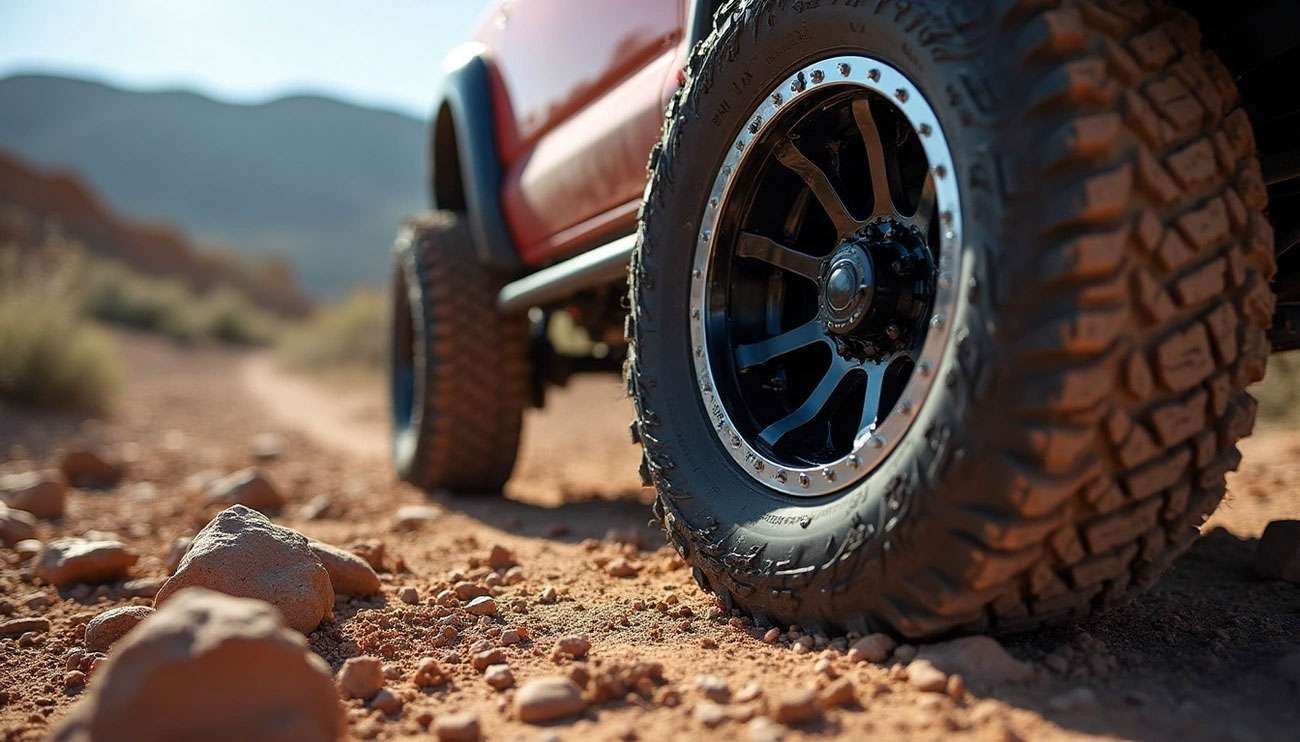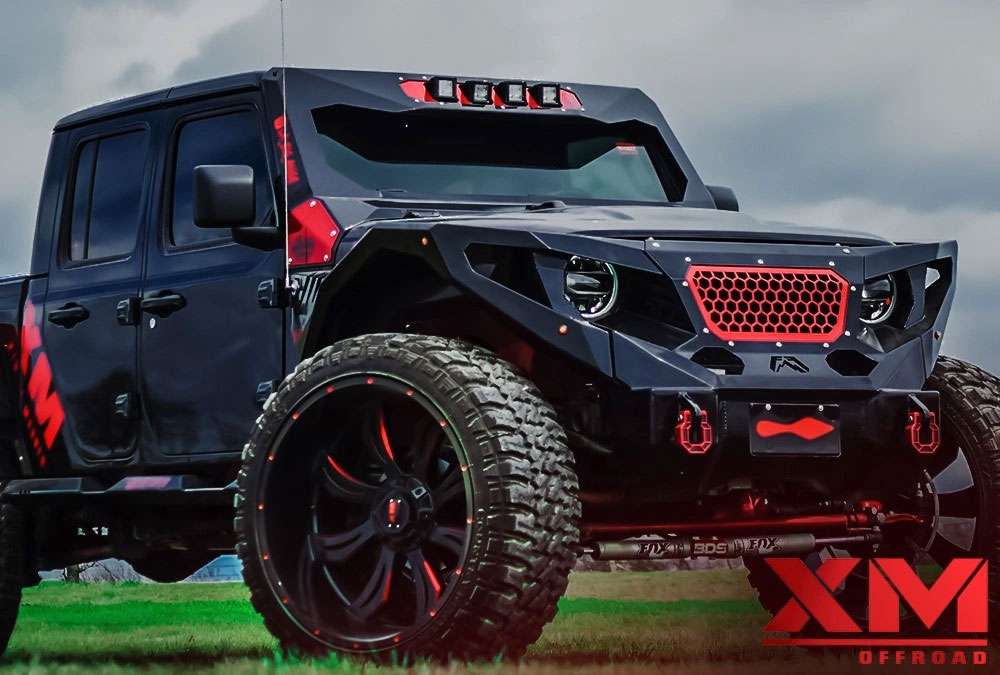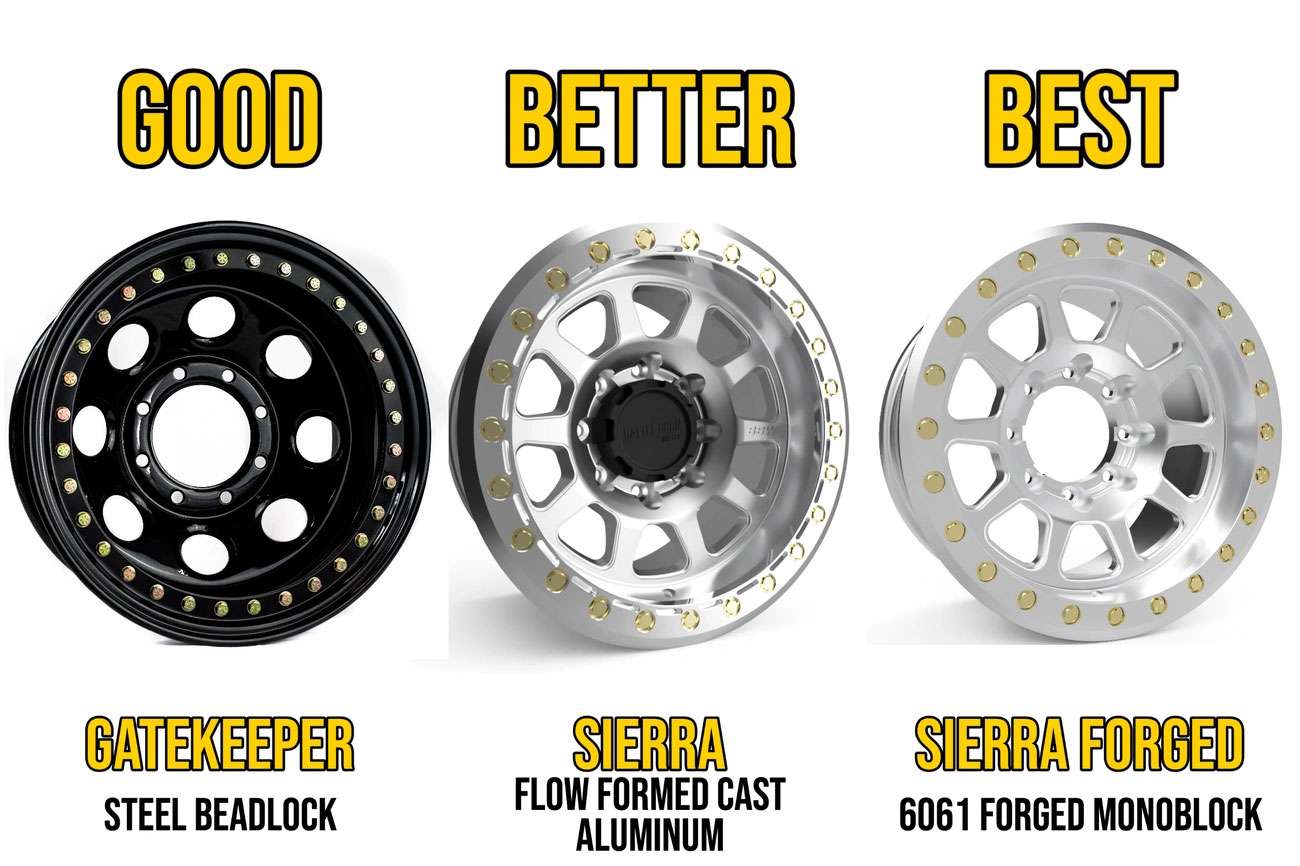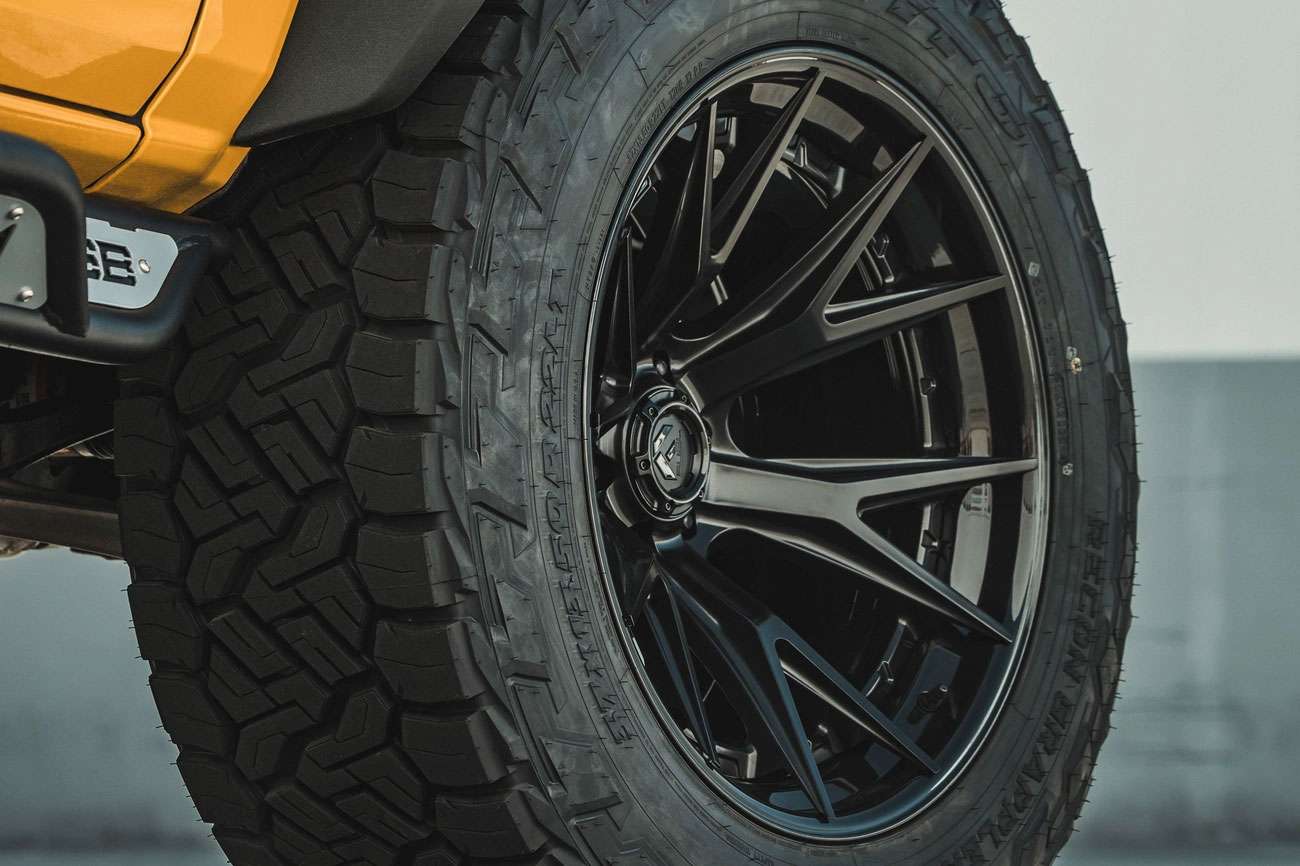
Smart off-road enthusiasts know that upgrading wheels delivers serious bang for your buck—often under $1,000 for a complete set that genuinely changes how your rig performs. Sure, plenty of folks start shopping for custom wheels because they want their truck or SUV to look tougher, but the real story lies in what quality off-road wheels actually do for your vehicle's capability out on the trails.
Here's what we've learned after years of helping customers find the right setup: good off-road wheels make a huge difference in traction and handling, especially when you're dealing with terrain that leaves factory wheels struggling. Your stock wheels were designed for grocery store runs and highway cruising—not for the kind of punishment you'll dish out on rocky trails or sandy washes.
The material you choose matters more than most people realize. Aluminum wheels keep weight down and help your fuel economy, while steel wheels can take an absolute beating when you're crawling over boulders. Most serious off-roaders do best with wheel diameters between 15 and 20 inches, paired with widths from 7 to 12 inches. These numbers aren't just specifications—they directly affect how your vehicle handles different types of terrain.
What surprises many customers is how quality wheels can actually boost your truck's resale value down the road. Better wheels mean less stress on your suspension components and more even tire wear, which translates to real money saved over time. Whether you're planning weekend trail runs or serious backcountry adventures, your wheels are literally where the rubber meets the rock—and getting this connection right makes all the difference.
Most customers walk into our shop talking about how they want their truck to look meaner, but the best off road wheels deliver way more than just curb appeal.
Your factory wheels were built to satisfy every possible buyer—which means they don't excel at anything specific. Aftermarket wheels flip that script entirely. Custom off-road rims come in various styles, sizes, and finishes that simply don't exist in the OEM world. More importantly, quality aftermarket options are purpose-built for the kind of abuse you'll throw at them on trails, with engineering that goes far beyond what manufacturers put on their trucks.
We see this difference every day. Stock wheels prioritize cost-cutting and mass appeal. Aftermarket wheels focus on performance, durability, and giving you exactly what your specific setup needs.
The right wheels completely change your vehicle's personality. We've watched countless customers roll out of here with the same truck they drove in, but now it actually looks like it belongs on a trail. Best offroad wheels don't just make your rig look tougher—they make it sit right, with the kind of stance that tells everyone you're serious about getting off the pavement.
Different wheel sizes and offsets change your vehicle's proportions in ways that photos can't capture. Your truck sits wider, looks more planted, and commands attention whether you're parked at the trailhead or cruising through town.
Every design choice on good off road wheels affects how they perform when it counts. Take wheel diameter—we always tell customers to follow the basic rule that wheel diameter should be no larger than half the tire height. Running 15 or 16-inch wheels with 33-inch tires gives you that sweet spot between ground clearance and sidewall protection.
Backspacing and offset might sound like technical mumbo jumbo, but these measurements determine where your wheel sits in relation to your suspension. Get the backspacing wrong, and you'll either be rubbing your fenders or creating steering problems that'll make trail driving miserable. Get it right, and you can run wider tires with better stability.
Material choice comes down to matching your wheels to your adventures. Steel wheels can take rock hits that would crack aluminum, making them perfect for serious rock crawling. Aluminum wheels save weight and improve handling, plus they look better longer. Both have their place—it just depends on where you plan to point your truck.

Image Source: Xtreme Mudder
Quality off-road wheels aren't just about looking good—they fundamentally change how your vehicle performs when the pavement ends. After helping thousands of customers upgrade their setups, we can tell you exactly what happens when you swap out those factory wheels for something built for real trail work.
The difference in grip becomes obvious the moment you hit loose dirt or rocky terrain. Quality off-road wheels let you safely run lower tire pressures without worrying about the tire bead popping off the rim, especially with beadlock designs. This means better ground contact and way more grip when you need it most. Wider wheels create a larger footprint that keeps you stable in loose sand or gravel conditions.
Here's a number that might surprise you: reducing tire pressure by 25-30% can boost your off-road traction by up to 40% according to the Rubber Manufacturers Association study. That's a massive improvement for a simple adjustment that's only possible with the right wheels.
Weight matters more than most people think. Quality forged and aluminum alloy wheels cut down on unsprung weight, which means your suspension can react faster to what the trail throws at you. Less weight spinning around also means your truck responds quicker when you need to change direction or power through obstacles. Your suspension works more efficiently when it's not fighting heavy wheels, allowing faster reaction times to terrain changes.
Increasing wheel diameter gives you the clearance you need to tackle bigger obstacles without scraping your undercarriage. Larger wheels raise your ride height and improve your approach and departure angles—critical when you're climbing over rocks or steep drops. Finding the right wheel size for your setup creates the perfect balance between clearance benefits and handling performance, especially important on technical rocky trails.
Proper wheel selection makes a huge difference in comfort, even on the nastiest terrain. Wheels that leave room for adequate tire sidewall absorb impacts much better, so you're not getting beat up every time you hit a rock. Smaller rim diameters (usually 17-inch or less) allow more tire sidewall to act as natural cushioning over obstacles. Forged wheels handle impacts from rocks, drops, and sudden hits better than cast alternatives, reducing your risk of damage. The result is a more controlled, comfortable ride that keeps you focused on the trail ahead instead of fighting your steering wheel.

Image Source: Battle Born Wheels
When you're shopping for off-road wheels, understanding how they'll hold up under punishment becomes just as important as how they look on your truck. We've seen plenty of customers learn this lesson the hard way—after their first rock crawling session or desert run shows them what "extreme conditions" really means.
Steel and aluminum each bring something different to the table, and knowing which fits your style of off-roading can save you headaches down the trail. Steel wheels are nearly impossible to crack under extreme conditions, which makes them the go-to choice for serious rock crawlers. Here's the thing about steel—if you do manage to bend one on a particularly nasty obstacle, you can often hammer it back into shape right there on the trail. Try that with aluminum and you'll likely end up walking out.
Aluminum alloy wheels tip the scales at about 2.5-3x less than comparable steel options, and that weight difference shows up in better acceleration and fuel efficiency. Forged aluminum wheels give you the best strength-to-weight combination available, though your wallet will definitely feel the difference.
Every wheel we sell has to meet specific load capacity requirements—that's the maximum weight a wheel can safely support. We take this seriously because wheel failure isn't just expensive; it's dangerous. Industry testing puts wheels through radial fatigue tests, cornering fatigue tests, and impact tests to make sure they can handle real-world abuse.
Quality aftermarket wheels are built with stronger materials specifically engineered for off-road punishment. Look for wheels with reinforced beads if you plan on airing down frequently—they'll protect against rock damage when you're running lower trail pressures.
For customers who push their rigs to the absolute limit, beadlock wheels offer a level of security that standard wheels simply can't match. These specialized wheels mechanically clamp the tire bead to the wheel, which means your tire stays put even when you're running extremely low pressures. We're talking as low as 5-7 psi without worrying about the tire coming off the rim.
Fair warning though—beadlocks demand respect. Proper installation with correct torque specifications isn't optional; get it wrong and you're looking at catastrophic failure. When installed correctly, beadlocks prevent tires from popping off during aggressive maneuvers, but remember that most aren't DOT-approved for street use. Perfect for trail rigs, but you'll need a different setup for your daily driver.

Image Source: Duramax Forum
Quality off-road wheels pay for themselves over time—and we see this proven again and again with customers who've made the upgrade. The upfront investment in good wheels creates a ripple effect of savings that touches everything from tire costs to suspension maintenance.
When your wheels are properly sized and fitted, your tires last significantly longer. Proper wheel alignment helps tires wear evenly, eliminating the need for premature replacements. We've seen too many customers burn through expensive off-road tires because their misaligned wheels created uneven stress patterns. Regular alignment checks and the right wheel setup prevent those costly toe and camber wear issues that can cost hundreds in early tire replacements.
Bad wheel choices create a domino effect throughout your suspension system. Poorly aligned wheels don't just hurt your tires—they also hammer your steering and suspension components, leading to premature wear and expensive repairs. Aluminum wheels require way less babying compared to steel options since they resist corrosion without constant repainting or special treatments. When your wheel setup is dialed in correctly, you'll replace worn suspension parts far less often because the whole system operates under less strain.
Premium wheels can add hundreds or even thousands to a vehicle's final selling price. That might sound too good to be true, but buyers recognize quality when they see it. Studies show that cutting 10 pounds of wheel weight can boost fuel efficiency by up to 2%, which adds up to real savings at the pump. High-quality aftermarket wheels signal to potential buyers that you've taken care of your rig, making it more attractive in a competitive marketplace. These wheels tell the story of a well-maintained vehicle, often commanding higher resale prices than trucks rolling on factory wheels.
The bottom line? Good off-road wheels represent one of the smartest investments you can make, paying dividends from day one through the day you sell.
Here's the bottom line: upgrading to quality off-road wheels ranks among the smartest moves any trail enthusiast can make. We've seen too many folks chase flashier modifications while ignoring the foundation that actually makes everything else work better.
Good wheels don't just change how your rig looks—they change how it performs when you need it most. The right setup gives you better traction on loose surfaces, more control on technical sections, and the confidence to tackle trails you might have avoided before. Plus, getting the weight and sizing right means your suspension works more efficiently and your tires last longer.
The material choice really comes down to your priorities. Steel wheels can take serious abuse and you can fix them trailside with a hammer if needed, but they're heavy. Aluminum options save weight and improve handling, though they cost more upfront. For the hardcore crowd, beadlocks open up possibilities you just can't get any other way—though they require more attention and aren't street legal in most cases.
What catches many customers off guard is how much money quality wheels can save them over time. Better tire wear, less stress on suspension parts, and improved resale value add up to real dollars back in your pocket. It's one of the few modifications that actually pays for itself.
Don't think of premium wheels as just another accessory. They're the contact point between your vehicle and the terrain—everything else depends on getting this right. Whether you're planning serious backcountry exploration or just want to handle weekend trails with more confidence, the right wheels make that difference you can feel every time you hit the dirt.
Q1. What are the main benefits of upgrading to off-road wheels? Off-road wheels offer improved traction, better handling on rough terrain, enhanced ground clearance, and a smoother ride over obstacles. They also provide durability in harsh conditions and can increase your vehicle's resale value.
Q2. How do off-road wheels affect fuel efficiency? Quality off-road wheels, especially those made of aluminum alloy, can reduce the overall weight of your vehicle. This weight reduction can improve fuel efficiency by up to 2% for every 10 pounds saved, leading to long-term savings.
Q3. Are beadlock wheels worth the investment for off-roading? Beadlock wheels can be valuable for extreme off-roading as they prevent tire separation at very low pressures (as low as 5-7 psi). However, they require careful installation and maintenance, and most aren't DOT-approved for street use.
Q4. How do off-road wheels impact tire wear? Quality off-road wheels promote even tire wear patterns, which can significantly extend tire lifespan. Proper wheel alignment associated with good off-road wheels can eliminate the need for premature tire replacements, saving money in the long run.
Q5. What's the ideal wheel size for off-road use? The best wheel size for off-road use typically ranges from 15 to 20 inches in diameter and 7 to 12 inches in width. A good rule of thumb is that the wheel diameter should be no larger than half the tire height to optimize the balance between clearance and performance.